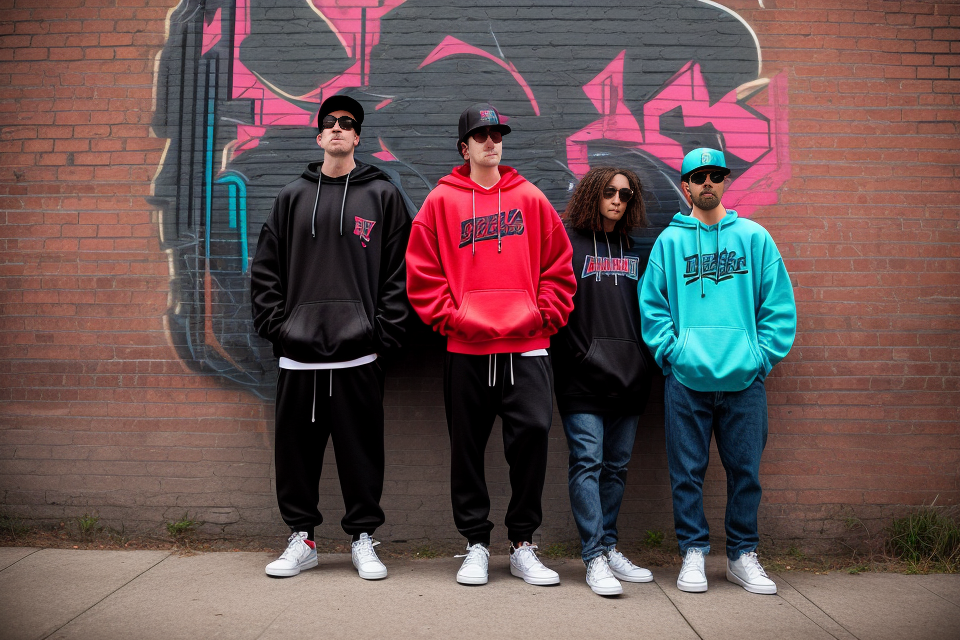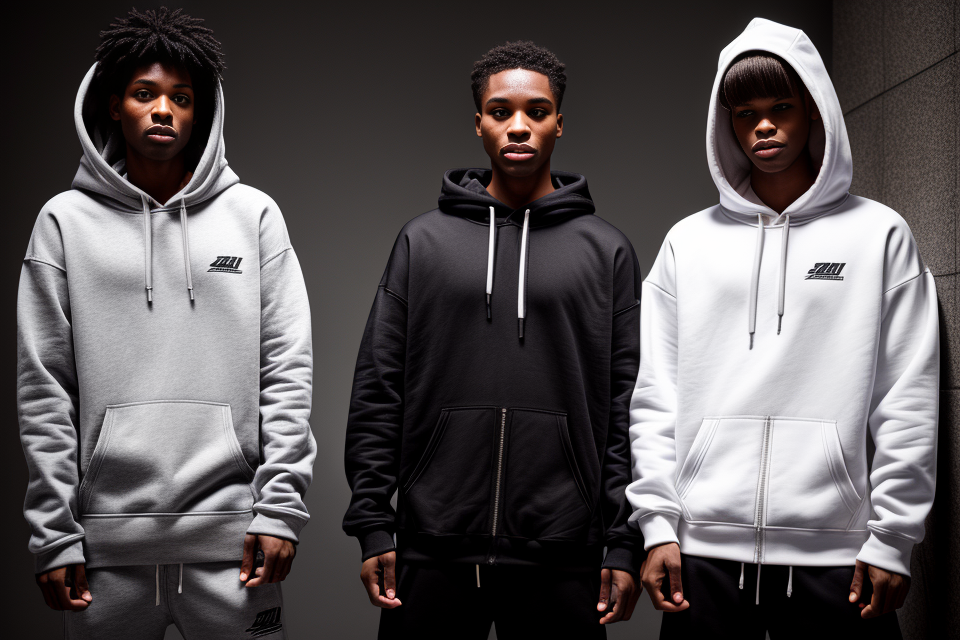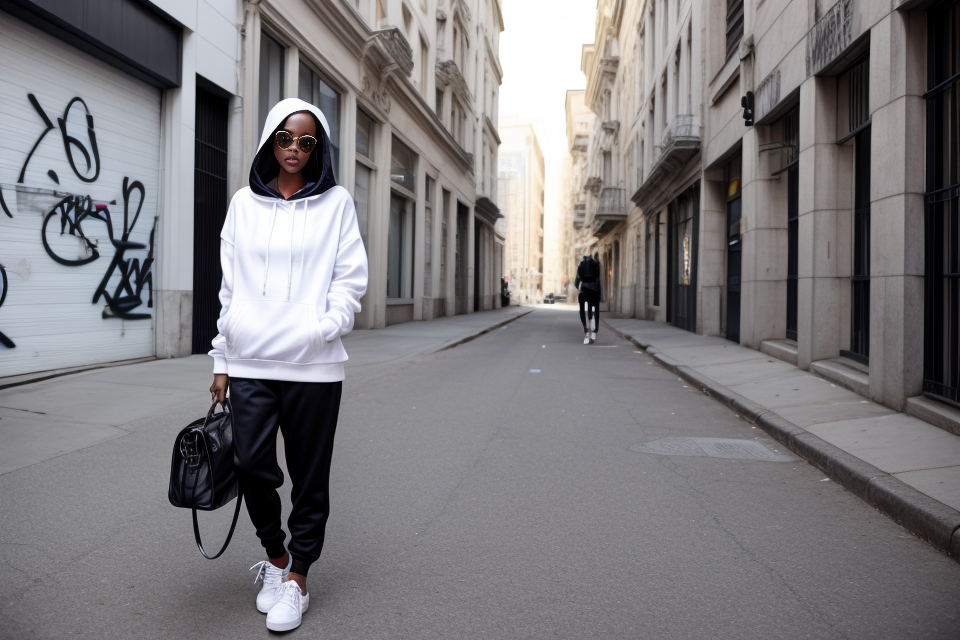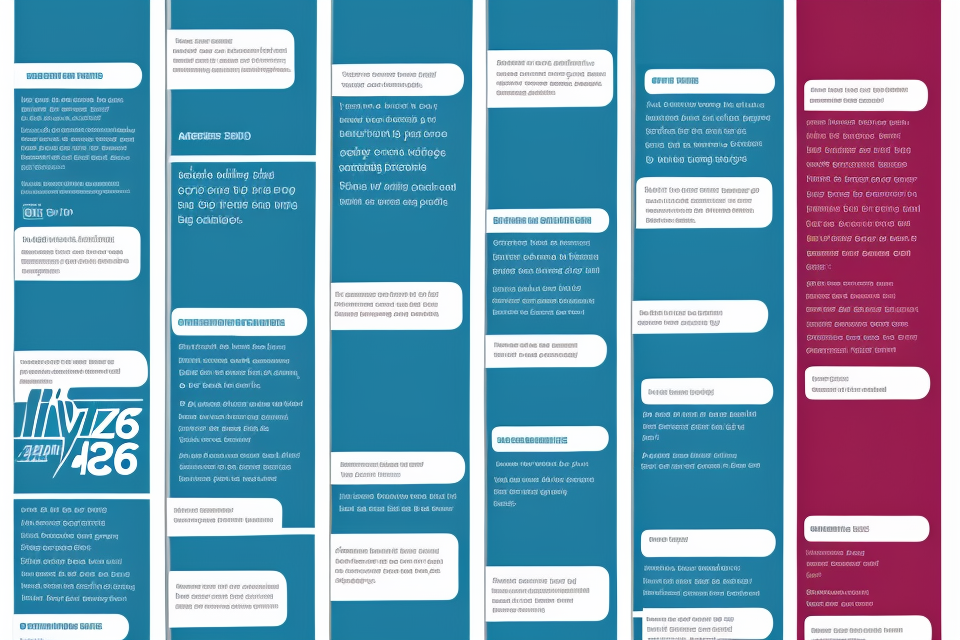
The 1980s was a decade of bold fashion statements, and one clothing item that has become synonymous with the era is the hoodie. But were hoodies really a thing in the 80s? In this article, we will explore the history of zip-up hoodies and how they became a staple in 80s fashion. From their humble beginnings as utilitarian workwear to their rise as a symbol of rebellion and street culture, we will delve into the story of the hoodie and its enduring appeal. So, let’s get ready to uncover the truth about this iconic garment and find out if it was indeed a defining feature of the 80s.
The 80s: A Fashion Era
Popular 80s Fashion Trends
The 1980s was a decade of bold and distinctive fashion trends that continue to influence contemporary style. From neon colors to shoulder pads, the 80s were characterized by a mix of glamorous and sporty looks.
Neon Colors
Neon colors were a prominent feature of 80s fashion, with bright shades such as pink, green, yellow, and blue being popular choices. These colors were often seen in clothing, accessories, and even hairstyles. Celebrities and fashion icons like Madonna and Cyndi Lauper helped popularize the trend, and neon colors were frequently seen on runways and in music videos.
Shoulder Pads
Shoulder pads were another iconic fashion trend of the 80s. Originally designed to give women a more masculine appearance, shoulder pads became a popular fashion statement for both men and women. They were commonly used to create a more defined shoulder line and give clothing a structured, box-like appearance. Shoulder pads were often seen in blazers, dresses, and tops, and were considered a key element of the power dressing look.
Leg Warmers
Leg warmers were a practical fashion accessory that gained popularity in the 80s. Originally designed for athletes to keep their legs warm during exercise, leg warmers became a fashion statement in their own right. Made from materials such as spandex and nylon, leg warmers were worn over tights or leggings and were often seen with high-top sneakers. The trend was popularized by celebrities such as Janet Jackson and was featured in a number of 80s music videos.
Big Hair
Big hair was a defining feature of 80s fashion, with elaborate hairstyles becoming increasingly popular. From perms and teased hair to crimping and hairspray, big hair was a way for people to express their individuality and make a statement. Celebrities such as Madonna and Whitney Houston helped popularize the trend, and big hair was frequently seen on runways and in music videos.
The Emergence of Hip Hop Culture
The 1980s marked a significant turning point in popular culture, with the emergence of hip hop as a distinct artistic and cultural movement. While hip hop had its roots in the 1970s, it was during the 1980s that it began to gain widespread mainstream recognition. The four key elements of hip hop culture – breakdancing, graffiti, DJing, and rapping – each played a crucial role in shaping the cultural landscape of the time.
Breakdancing
Breakdancing, also known as b-boying or breaking, was one of the most visible aspects of hip hop culture in the 1980s. It originated in the Bronx, New York, and was characterized by intricate and acrobatic dance moves performed to the beat of hip hop music. Breakdancing was often accompanied by rhythmic clapping and stomping, known as “chanting,” and was often performed in groups, with dancers taking turns to showcase their skills.
Graffiti
Graffiti, another key element of hip hop culture, emerged as a way for artists to express themselves through vibrant and dynamic visual art. Graffiti was often created using spray paint, and the art form was characterized by its use of bold colors, dynamic lines, and intricate patterns. While graffiti had existed prior to the emergence of hip hop, it was during the 1980s that it began to be associated with the movement, with many of the most prominent graffiti artists being affiliated with hip hop crews.
DJing
DJing, or disc jockeying, was another key element of hip hop culture in the 1980s. DJs played a crucial role in shaping the sound of hip hop, creating new and innovative mixes by blending different songs and sounds together. DJs were also instrumental in introducing new artists and styles to the hip hop scene, and were often the driving force behind the popularity of certain tracks and artists.
Rapping
Rapping, or MCing, was the fourth key element of hip hop culture in the 1980s. Rapping involved rhythmic spoken word delivery over a beat, and was often used to convey messages, tell stories, or express personal experiences. Rapping was often accompanied by other elements of hip hop culture, such as breakdancing and graffiti, and was a key part of the overall aesthetic of the movement.
Overall, the emergence of hip hop culture in the 1980s had a profound impact on popular culture, influencing everything from fashion and music to art and language. The four key elements of hip hop – breakdancing, graffiti, DJing, and rapping – each played a crucial role in shaping the cultural landscape of the time, and continue to be an important part of the movement to this day.
The Rise of Hoodies in the 80s
The 80s Hoodie: A New Twist on an Old Classic
In the 1980s, the hoodie underwent a transformation, becoming a fashion statement that was both edgy and iconic. The 80s hoodie was a new twist on an old classic, featuring unique design elements that set it apart from previous iterations.
The Hoodie as a Fashion Statement
During the 1980s, the hoodie began to emerge as a fashion statement, with a range of brands and designers experimenting with new styles and colors. The hoodie was no longer just a functional piece of clothing for outdoor activities; it had become a fashion statement that was worn by both men and women.
One of the key factors that contributed to the rise of the hoodie as a fashion statement was the influence of streetwear culture. As hip-hop and other urban genres gained popularity, so did the hoodie, which had long been associated with sportswear and casual clothing. The hoodie became a symbol of urban cool, and was often worn with denim jackets, baggy jeans, and sneakers.
The Evolution of the Hoodie Design
In the 1980s, the hoodie underwent a significant evolution in terms of its design. One of the most notable changes was the introduction of the drawstring hood, which allowed wearers to adjust the fit and keep their neck warm. The drawstring hood was a departure from previous hoodie designs, which had fixed hoods that did not offer much flexibility.
Another important design change was the introduction of the full-zip hoodie. Prior to the 1980s, most hoodies had a half-zip or no zip at all, making it difficult to regulate body temperature. The full-zip hoodie allowed wearers to adjust the amount of warmth they needed, making it a more versatile piece of clothing.
Brands that Popularized Hoodies in the 80s
A number of brands played a key role in popularizing the hoodie in the 1980s. One of the most iconic was Champion, which had been producing hoodies since the 1930s. In the 1980s, Champion continued to innovate, introducing new colors and designs that were popular with consumers.
Another brand that played a significant role in the rise of the hoodie was Nike. Nike’s hoodies were popularized by athletes, who wore them as part of their training and competition gear. Nike’s hoodies were often made from lightweight, breathable materials, making them ideal for athletic activities.
Overall, the 80s hoodie was a new twist on an old classic, featuring unique design elements that set it apart from previous iterations. Whether worn as a fashion statement or for practical purposes, the hoodie became an iconic piece of clothing that remains popular to this day.
Hoodies in Pop Culture
Hoodies have been a popular clothing item for decades, but they truly rose to fame in the 1980s. This was thanks in part to their appearances in popular culture, which helped to cement their status as a fashion staple. Here are a few examples of how hoodies were featured in pop culture during the 1980s.
- The film “Wild Style”
“Wild Style” is a 1983 film that is often credited with helping to popularize hip hop culture. The film features a number of iconic hip hop fashion items, including hoodies. The main character, played by actor Lee Quiñones, is often seen wearing a hoodie, which helped to establish the garment as a fashion statement.
- The music video “Thriller”
The “Thriller” music video, released in 1983, was a cultural phenomenon that helped to make Michael Jackson a global superstar. The video features Jackson wearing a black hoodie, which has since become one of the most iconic images from the video. The hoodie helped to add a sense of mystery and danger to Jackson’s character, and it cemented the garment’s status as a fashion item.
- The TV show “Miami Vice”
“Miami Vice” was a popular TV show that aired from 1984 to 1989. The show was known for its stylish fashion, and it helped to popularize a number of 1980s fashion trends. One of the most iconic looks from the show was the hoodie, which was often worn by the main characters, played by actors Don Johnson and Philip Michael Thomas. The hoodie helped to give the characters a sense of coolness and sophistication, and it helped to establish the garment as a fashion staple.
The 80s Hoodie: A Symbol of Rebellion
The Hoodie as a Political Statement
The 1980s were a time of great social and political change, and the hoodie became a symbol of resistance for those who felt marginalized by the mainstream culture. Anti-establishment movements such as punk rock and hip hop emerged during this period, and the hoodie became a staple of their fashion, serving as a statement of rebellion against societal norms.
The use of hoodies as a symbol of resistance can be traced back to the civil rights movement of the 1960s, where hooded protesters would use their hoods to hide their identities while participating in acts of civil disobedience. This association of the hoodie with resistance and activism continued into the 1980s, where it became a popular choice for those who sought to express their dissatisfaction with the status quo.
In addition to its association with resistance, the hoodie also became associated with criminal activity during the 1980s. This was due in part to the media’s portrayal of hoodie-wearing individuals as being involved in criminal activity, leading to a negative stereotype of the hoodie as a symbol of delinquency. However, it is important to note that this association was largely based on racial and class biases, and did not accurately reflect the reality of hoodie-wearing individuals.
Overall, the hoodie in the 1980s was a symbol of rebellion and resistance, as well as a reflection of the political and social climate of the time. It served as a means of expressing dissatisfaction with the mainstream culture and challenging societal norms, while also facing criticism and backlash due to its association with criminal activity.
The Hoodie as a Fashion Statement
During the 1980s, hoodies emerged as a fashion statement that represented a sense of nonconformity and rebellion. Young people, particularly those who were part of the emerging hip-hop culture, began to use hoodies as a way to express their individuality and assert their independence from mainstream fashion.
The hoodie’s versatility made it an attractive choice for those who wanted to create a unique style that set them apart from others. The oversized silhouette and drawstring hood provided endless possibilities for layering and styling, and the garment’s simple design allowed for easy customization with graphics, logos, and other embellishments.
Moreover, the hoodie’s association with urban streetwear fashion further elevated its status as a fashion statement. The hoodie became a symbol of urban culture, representing a connection to the streets and a rejection of traditional fashion norms. As a result, the hoodie’s popularity continued to grow throughout the 1980s, cementing its status as a wardrobe staple for those who sought to express their individuality and make a statement through their clothing choices.
The 80s Hoodie: A Timeless Classic
The Resurgence of 80s Fashion
- In the 2010s, 80s fashion trends experienced a resurgence in popularity
- This revival can be seen in the fashion choices of celebrities and influencers
- The trend has also impacted the fashion industry, with many brands introducing 80s-inspired clothing lines
- The resurgence of 80s fashion has been attributed to a desire for nostalgia and a need for comfort and simplicity in clothing
- Additionally, the 80s fashion trend has been embraced by the streetwear community, which has helped to keep the style relevant and fresh.
The 80s Hoodie: A Classic Piece
- The longevity of the hoodie design
The hoodie has been a staple in fashion for decades, with its origins dating back to the 1930s. However, it was during the 1980s that the hoodie truly came into its own as a fashion statement. The simple yet versatile design of the hoodie, with its kangaroo pocket and drawstring hood, has allowed it to transcend fashion trends and remain a timeless classic. - The enduring popularity of 80s hoodies
The 1980s saw the hoodie become a mainstay in popular culture, with everyone from rappers to movie stars sporting the fashion statement. This popularity was due in part to the hoodie’s ability to be worn both as a casual, everyday garment and as a statement piece. Even today, the 80s hoodie remains a popular choice for both fashion-conscious individuals and those simply looking for a comfortable, functional piece of clothing. - The influence of 80s hoodies on modern hoodie design
The 80s hoodie had a significant impact on the evolution of the hoodie as a fashion statement. Many of the design elements that were popular in the 80s, such as bold colors and graphic prints, continue to influence modern hoodie design. Additionally, the 80s hoodie helped to establish the hoodie as a staple in the wardrobes of both men and women, making it a ubiquitous presence in contemporary fashion.
FAQs
1. What is a hoodie?
A hoodie is a type of sweatshirt that has a hood attached to the back of the neckline. The hood is typically made of the same material as the sweatshirt and can be pulled over the head for added warmth and protection from the elements.
2. When did hoodies become popular?
Hoodies have been around since the early 20th century, but they didn’t become widely popular until the 1980s. During this time, hoodies were often worn as a casual, everyday garment, and they became a staple of the streetwear and hip-hop fashion scenes.
3. Were hoodies a thing in the 80s?
Yes, hoodies were definitely a thing in the 1980s. In fact, they became increasingly popular during this decade, especially among young people and athletes. Many companies began producing hoodies in a variety of colors and styles, and they were often worn as a casual, everyday garment.
4. How has the hoodie evolved over time?
Over the years, the hoodie has evolved in terms of both design and materials. Today’s hoodies are often made from high-tech fabrics that offer superior warmth and breathability, and they may feature a variety of design elements, such as pockets, zippers, and embroidery. Additionally, hoodies have become more fashionable and are often worn as a statement piece, rather than just a utilitarian garment.
5. Where can I find vintage hoodies from the 80s?
If you’re looking for vintage hoodies from the 1980s, you may be able to find them at thrift stores, flea markets, or online auction sites. You can also try contacting collectors or dealers who specialize in vintage clothing. However, keep in mind that many vintage hoodies may have wear and tear, and they may not fit as well as modern hoodies.


